***
N. China
Day 5 - 3rd November - Beijing: Tiananmen, The Forbidden City - Harmonious Buildings (Part 1)
Before the night train from Taishan pulled in to the station, the train attendants cleaned the toilets with Chinese state of the art toilet cleaning - just using hot water to splash the area.
The night train arrived early, at 5+am, so I decided to have some breakfast first. The hostel reception would probably come if I banged on the door, but I'd let them sleep in a little first (besides, none of the attractions were open so early). So I went for breakfast, and tucked into an authentic recipe beloved by a billion Chinese:
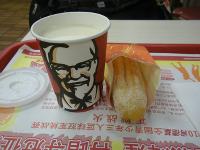
Okay, so sugar-coated youtiao and hot doujiang (豆浆- soya bean drink; the cold version was not available and they probably thought me crazy for asking for it) may not be made to the same exacting standards as the Colonel's 11 (actually, this was the first time I'd ever had sweet, let alone sugar-coated youtiao) but Original Recipe chicken wasn't available in the morning anyway, and I'd tried KFC porridge before (and further didn't feel like it this time), so this was something new.
In any case, the doujiang was almost as watered down and tasteless as everyone else in China (I had been very unimpressed by the doujiang around Shanghai too). My theory is that because China is (relatively) poor, most people water down their doujiang until it is almost tasteless so it is cheaper, so people are used to drinking flavourless doujiang. Charis said that one had to distinguish between 豆浆 and 豆奶 (dounai) - the former was diluted and the latter concentrated.
One Baidu user had a long answer:
"豆奶是不是等同于豆浆呢?答案是否定的,专业书籍这样介绍豆奶的加工工艺:将大豆经浸泡、磨碎、过滤、调制、超高温加热、脱臭、高压均质、冷却等加工过程,制成均质、奶样、乳白色的液体,即豆奶。由此可见,豆奶是在豆浆的基础上再经超高温加热、脱臭、高压均质等过程制得,这是豆浆制作工艺中所没有的,目前流行的家用豆浆机、家用豆奶煲等是做不出豆奶的。"
Basically dounai is subjected to heat and pressure in its production.
Another article claims dounai has milk in it.
A more concise answer (from the first link):
"我想是豆浆,因为豆浆比豆奶难吃。" ("I think doujiang [has more nutritional value] because it tastes worse than dounai")
Compared to the rest of China, KFC had a clean restaurant, had clean food, and had a nice, modern and comfortable environment. Perhaps due to the early hour, a lot of free riders were also sitting around without having bought anything. The crowning glory of KFC, though, was its toilet: Clean! Dry! Warm Water Tap! And with Toilet Paper!!! No wonder it was so popular in China! It also wasn't overheated, like many European indoor locations, but I suspect that had more to do with saving electricity than customer comfort.
Looking around the restaurant, I noticed I was the only one in (just) a T-shirt. Which led me to devise a good rule of thumb: if others are removing their jackets, it's overheated. If I am putting on mine, it's underheated.
While eating my breakfast, I kept looking out for the KFC slogan "在肯德基,我们做鸡是对的" ("At KFC, we do Chicken right") but didn't see it. I should also have looked out for "舔掉手指头" ("Finger lickin' good")

The Return of Shu Qi. She's back!
I followed a sign and walked towards the subway. Only to realise that the sign had pointed to the subway's exit, and I couldn't enter the station from there. Grr.
There was a chain, "美国加州牛肉面" (Californian Beef Noodles). Maybe they sold chop suey.

This must be how PRCs learn English. That's why the nice guy on the way to Zoukoudian, pointing to the duct, said "而肯" (er2 ken3 - "air con").

SMU Car Rental ad in the subway
I had been a bit apprehensive about the hostel for this night, as it was to be the cheapest of my 4 hostels, after my most expensive hostel (25¥/night, versus 100¥/night). Yet it was very nice and new. The low price was probably because it was not *quite* as centrally located as the others (though it was actually nearer to the subway station than all but my last hostel).

"Please save water so that we can offer our guests more cheaper price" - Bruce Lee
Since it was still early (7+am) and my room wasn't ready yet, I asked if I could crash on the sofa - and was given some bedding. You couldn't do this at a hotel. I love hostels.
When I was awoken and told that my room was ready, I decided it was ready so set out, and so I did, at about 9, which was very slack by my standards. Indeed most of my days in Beijing were relatively slack - I was only hurried in the sense of moving from city to city quickly.


Houmao Hutong under renovation - this was right outside the hostel door. I hope they're not rebuilding it à la Singapourienne.
On my way to the subway I helped a French couple find the place, and they were very happy to find someone who spoke their language. Hurr hurr.

My breakfast: a super-hot bing (egg, spring onion, coriander, bean paste and skin). So hot that I couldn't eat it immediately - but that also meant it was too hot to give me food poisoning. I actually asked for a meat bing, but although it was advertised it was not available in the morning as it was against their religion or something.
I was weighing various translations of bing in my mind - the first that came to mind, "biscuit", was very inappropriate (I blame the association with "饼干") but I realised that "crêpe" was perfect - even if all of the bings I had fell far short of even the worst crêpe that I'd ever eaten (whenever I ate bings after the first time, it was because they were the least bad choice). I'm not sure if it was a Northern Chinese thing as, come to think of it, I hadn't tried any bings in Shanghai.

Cute ad for panda eyes

This sign says not to "rush into the train or block the train doors as they are closing", but looks more like "don't commit suicide by throwing yourself in front of the train"
It's probably a good thing that while there were many signs banning things, none that I can remember at this juncture prescribed fines or other penalties, unlike the Fine City. Yet this was probably because in this Communist State, you don't need the Rule of Law to be punished - you just disappear in the night if you do something wrong.

Customised credit cards - if got a Chinese credit card from the China Minsheng Banking Corp., Ltd., I could put Wo-hen Nankan's face on it!
I then headed to Tiananmen Square to look for tanks.
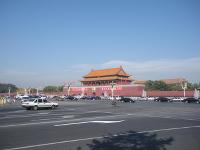




Tiananmen (the gate itself)


Flag in front of Tiananmen
I then entered the square itself.
Entrane to Tiananmen Square was very tightly controlled, with everyone having to have their bags sent through X-ray machines. Thus, I knew my fantasies of unfurling huge Tietan/Taiwanese/Falungong flags in Tianamen Square would never come to fruition. I could always shout “毛主席万岁” ("Long Live Chairman Mao") but people would just look at me strangely.
At one X-ray machine, one guy got his bag opened up after it went through. The object of interest? A sheaf of papers, which the police officer thumbed through. He had been afraid, of course, that it was a sheaf of Falungong pamphlets.

Cock Police Car
I'm not sure if it's more cock than the French firetruck in Montparnasse railway station:





"Monument to the People's Heroes... It is the largest such monument in Chinese history"
Obviously they need to go to the West and learn from the Barbarians and then build the largest such monument in the World
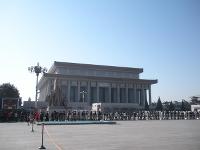

Queue to look at a Mummy

Monument at side of Mummy's Tomb
I then wanted to have a look at my first preserved body (Egyptian Mummies aren't quite the same). It was free, but I couldn't bring in my bag, camera or other things like that, so I had to go to a bag check, which was *not* free. I suspect some form of cross-subsidy (perhaps a concessionare fee)

"2 yuan: under 20 cm in height ( 20 cm inclusive ), in various shapes
3 yuan: from 20 cm to 30 cm in height
4 yuan: from 30 cm to 40 cm in height
5 yuan: from 40 cm to 50 cm in height
6 yuan: from 50 cm to 60 cm in height
7 yuan: from 60 cm to 70 cm in height
8 yuan: from 70 cm to 80 cm in height
9 yuan: from 80 cm to 90 cm in height
10 yuan: over 90 cm in height
single use camera, telescope, CD player: 2 yuan
ordinary optical camera, MP3 player, MP4 player, game console: 3 yuan
portable computer, digital camera, video camera, long--lens camera: 5 yuan"
Elaborately anal pricing structure. I was charged 11¥
At the entrance to the Maosoleum (Mao Mausoleum), there another concessionaire - one selling white flowers for 3¥. These long-stemmed specimens all looked the same. I speculated that when the maosoleum closed (strangely, it didn't open in the afternoons - perhaps Chinese scientists try to revive him in the afternoons), the vendor would go in and retrieve all of them and sell them the next day.
Inside, Chairman Mao looked spookily unnatural. A blanket was pulled up to cover most of his body, but his face looked waxy as if a mask was covering it. A Real Doll would've been more realistic. 2 PLA soldiers stood at attention behind - perhaps they had instructions to shoot him if he felt something was going wrong and got up.
Outside the Maosoleum there were more concessionaires. Their positioning was very cunning as they were placed before the exit of the Maosoleum compound. Since no one would have a camera, if you wanted a picture of yourself on the steps of the Maosoleum (albeit the rear ones), you would have no choice but to patronise these vendors at a price of 10¥.






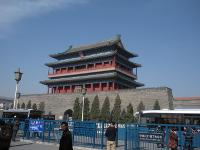
Qianmen (Zhengyangmen)
Formerly part of the city wall and south of Tiananmen Square. They used to have more of the inner city wall, but it was torn down to build the subway. In fact, they wanted to tear down this and other towers too, but Zhou Enlai saved them. We all love Zhou Enlai.

Looking after children: women's work
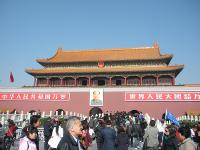

You will see some teenagers standing asturely on the bridge to Tiananmen. At first I thought they were being punished, but that didn't seem to be the case. They looked fierce though. If they were undercover PLA soldiers, it was not wise to advertise this fact by their behavior.

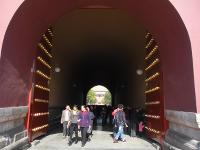

Duanmen

Ticket booths for a sideshow
That the signage was all in Mandarin meant the exhibition would be all in Mandarin, so I gave it a miss - if there's one thing more painful than speaking in Mandarin, it's reading Chinese characters. And if there's one thing more painful than reading Chinese characters, it's reading Chinese historico-cultural descriptions.
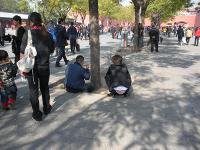
Nice underwear
Forbidden City: Entrance - The Grand Press
People, people and more people. That's China
One tout tried to lead a group of East Europeans to an "art exhibition" which was on its "last day". Wisely, they said no.

Pricing was strange. Qufu had cost 50¥ for each site, but the whole Forbidden City (well, two or three places had supplementary charges) was only 40¥. Notice that graduate students don't get student prices, but retirees do. Meanwhile those aged 60 only got half price - it seems there's an incentive not to work.

Price discrimination in audioguides: "Chinese languages" (normal Mandarin, kids' mandarin, Cantonese, Hokkien, Tibetan and Uigher) cost 10¥ and all other languages cost 40¥. Hey, it's worth losing some money to make a political statement (Tibetan and Uyghur are not Chinese languages - the fact that another script is needed makes that clear enough).
In any case, those are some languages: English, French, Spanish, Arabic, Japanese, Greek, Swedish, Italian, Bulgarian, Finnish, German, Portuguese, Czech, Korean, Dutch, Romanian, Bahasa Indonesia, Russian, something I can't figure out, Polish, Filipino, Turkish (or Persian), Urdu, Slovenian, something I can't figure out, Bengali, Vietnamese, Esperanto (!), something I can't figure out, Swahili, Hausa, Telugu (?), Hungarian, something I can't figure out and Bahasa Malaysia.
This is the most number of languages I've ever seen for audioguides. In fact it outnumbers the last record holder by 200-300% at least. One might expect me to be upset at the price discrimination, but they need to cover costs, and I can imagine it's hard to find Slovenian speakers (2.4 milion worldwide). Ideally they would charge accordingly - English would thus be the cheapest, while Arabic would be more expensive and Slovenian the highest of all, but I can imagine the difficulties in doing this.

High tech audioguide - it would automatically sound when you entered a place. This was actually a curse as sometimes it would sound when it was not supposed to, or not sound when it was supposed to. It also meant I couldn't pause or relisten to commentary (the woman activated it when she gave it to me, so I lost some commentary as I hung the tablet around my neck like a condemned criminal of old and stuck in the earphones). The woman also claimed I couldn't use my own earphones, grr.

You can't check in "illegal printed materials" and "items which smell". Presumably Falungong pamphlets should be brought with you to give out.


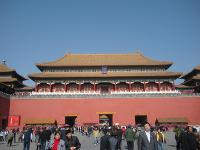
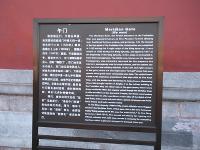
Meridien Gate
The central door could only be used by the Emperor, the 3 top scholars in the national examinations and the Empress on her wedding day.



Gate of Supreme Harmony and Square of Supreme Harmony in front
Morning court was held here.
Panorama - Gate of Supreme Harmony

Lion on left
The lions are "believed to be the biggest in the Forbidden City". Presumably they think some still lie buried.


Gate of Supreme Harmony
It used to be made possible by American Express (see the bottom) but not anymore. Maybe the sponsorship contract ran out.

Palace Museum plaque
This is the Chinese name for the "Forbidden City" - the latter of which comes about because messengers were forbidden to go beyond a certain point.
American Express still sponsors this one.


Square of Supreme Harmony
The centre was for the Emperor. The braziers would burn cypress and something else for atmosphere. Ahh, PR!
Hall of Supreme Harmony and Square of Supreme Harmony





Hall of Supreme Harmony and Square of Supreme Harmony


Hall of Supreme Harmony
The 11 beasts on the roof edges were not just to ward of evil but also to stop the roof tiles from falling off. The 11 beasts tell you the rank of the hall - this Hall has the most number of beasts in the Forbidden City.
The Hall of Supreme Harmony was proclaimed to be the biggest wooden building in China. In other words, it's not the biggest in Asia or even the World (that would be Todai-ji in Nara, Japan (itself 2/3 the size of the original hall on the current site)
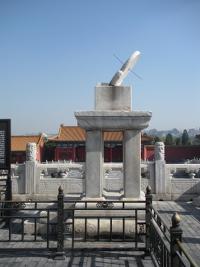

Sundial

Bird and turtle


Copper and Iron firefighting vats
The audioguide *had* to mention that they were 'unscrupulously' scraped when the West invaded during the Boxer Invasion. When I finally go to Korea and Vietnam, I'll be very interested in hearing their grievances against the Chinese.
Note also the "no scratch" sign - presumably people think they can join in the Western Barbarians of the last century in defacing Chinese heritage (it's a fair assumption if you see an already scratched pot, isn't it?) Interpreting the sign very literally, some PRCs touched it and banged it instead.

Hall of Supreme Harmony

Inside of Hall of Supreme Harmony

Gilded Dragon on door

Behind the Hall of Supreme Harmony, this is either a dragon on a one-horned beast that can run 1,000 km a day and speak all languages. Probably the latter, as nothing else seems to correspond to this.


Hall of Central Harmony - behind the Hall of Supreme Harmony
The audioguide called this the Hall of Medium Harmony. Tsk, coordination failure. Again notice American Express's support.
Here the Emperor rested before court, and also reviewed genealogy on a 10 yearly basis.
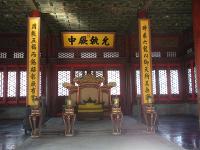
Inside Hall of Central Harmony
The stupid audioguide had refused to stop, so I had tried sitting on a bench previously and letting it ramble on. This had not worked - it was going on about the Hall of Preserving Harmony when I wasn't even at the Hall of Medium Harmony.
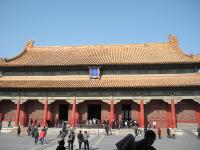



Hall of Preserving Harmony (Preserved Harmony according to the plaque)
Again, there's coordination failure. The Emperor would change his clothes here. During the Qing the highest exams in the system were held here; the Song Dynasty design with fewer pillars made it brighter and so good as an exam hall.

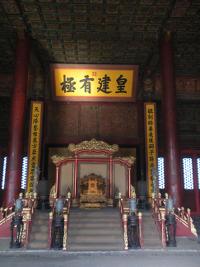
Hall of Preserved Harmony





Back of Halls of Medium and Supreme Harmony
For the heck of it I have activated the "tourist eraser" option (though I missed one obvious spot, and probably a few smaller ones). This is not really practical in places like the Forbidden City due to the crowds, but it worked here (not least since I had many pictures). This detracts from fidelity, though (philosophically anyway) so I'd rather not use it. Better an imperfect picture that's true to life than a perfect one that's engineered.
You will notice the architecture of the Forbidden City resembles that of some previously featured buildings. This theme will recur in future posts: Ming-Qing Architecture.
I realised I would actually spend more nights on trains (6 - with 4 of them in consecutive 2-night stretches) than on solid ground (4 nights in hostels and 1 in a hotel).
China has the thinnest plastic bags in the world.
According to Wikipedia on the Beijing Subway, "Before the flat fare was introduced on October 7, 2007, fares ranged from ¥3 to ¥7, depending on the line and number of transfers". The price actually went down (to ¥2). Wow.
I found Line 4 the most pleasant line of them. I have just found out that it is managed by the Hong Kong MTR. I now know why Line 4 was so good.